Suchergebnisse für "motor OR control OR projects OR with OR arduino OR raspberry OR pi"
-

Elektor Digital Motor Control - Projects with Arduino & Raspberry Pi (E-book)
This book is about DC electric motors and their use in Arduino and Raspberry Pi Zero W based projects. The book includes many tested and working projects where each project has the following sub-headings: Title of the project Description of the project Block diagram Circuit diagram Project assembly Complete program listing of the project Full description of the program The projects in the book cover the standard DC motors, stepper motors, servo motors, and mobile robots. The book is aimed at students, hobbyists, and anyone else interested in developing microcontroller based projects using the Arduino Uno or the Raspberry Pi Zero W. One of the nice features of this book is that it gives complete projects for remote control of a mobile robot from a mobile phone, using the Arduino Uno as well as the Raspberry Pi Zero W development boards. These projects are developed using Wi-Fi as well as the Bluetooth connectivity with the mobile phone. Readers should be able to move a robot forward, reverse, turn left, or turn right by sending simple commands from a mobile phone. Full program listings of all the projects as well as the detailed program descriptions are given in the book. Users should be able to use the projects as they are presented, or modify them to suit to their own needs.
€ 29,95
Mitglieder € 23,96
-

JOY-iT JOY-iT MotoPi - Motorsteuerung für Raspberry Pi
Die MotoPi-Platine ist eine Erweiterungsplatine zur Ansteuerung und Verwendung von bis zu 16 PWM-gesteuerten 5-V-Servomotoren. Der eigene Taktgeber auf dem MotoPi sorgt für ein sehr genaues PWM-Signal und somit auch für eine genaue Positionierung. Die Platine verfügt über 2 Eingänge für eine Spannung von 4,8-6 V, über die zusammen bis zu 11 A eingespeist werden können, so dass eine optimale Versorgung der Motoren stets gewährleistet ist und somit auch größere Projekte mit ausreichend Strom beliefert werden können. Die Versorgung läuft zentral über den MotoPi, der für jeden Motor separat einen Anschluss für Spannung, Masse und die Steuerleitung zur Verfügung stellt. Durch den eingebauten Kondensator wird der Strom zusätzlich gepuffert. Hierdurch wird das Einbrechen der Spannung bei kurzzeitiger Mehrbelastung abgemildert, die sonst zum Ruckeln führen könnte. Zusätzlich hat man noch die Möglichkeit, einen weiteren Kondensator anzuschließen. Der integrierte Analog-Digital-Wandler bietet neue Möglichkeiten wie z. B. die Steuerung über einen Joystick. Die Ansteuerung und Programmierung der Motoren kann (wie gewohnt) weiterhin bequem über den Raspberry Pi bedient werden. Anleitung und Codebeispiele erlauben auch Einsteigern, schnell Ergebnisse zu erzielen. Besonderheiten 16 Kanäle, eigener Taktgeber für Servomotoren (PWM), inkl. Analog-Digital-Wandler Eingang 1 Hohlstecker 5,5 / 2,1 mm, 4,8-6 V, 5 A max. Eingang 2 Schraubklemme, 4,8-6 V, 6 A max. Kompatibel mit Raspberry Pi A+, B+, 2B, 3B Maße (BxHxT) 65 x 24 x 56 mm Lieferumfang Platine, Bedienungsanleitung, Befestigungsmaterial, Retail-Verpackung
€ 26,95€ 13,50
Mitglieder identisch
-
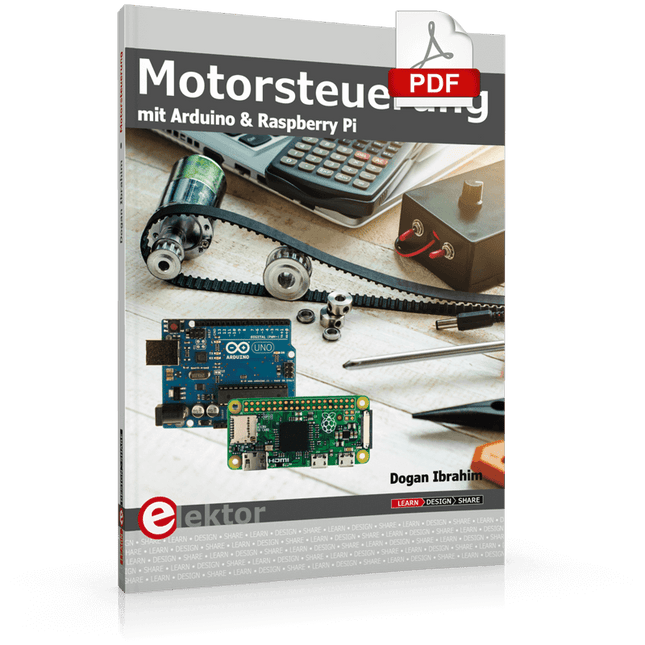
Elektor Digital Motorsteuerung mit Arduino und Raspberry Pi (PDF)
Dieses Buch beschäftigt sich mit DC-Elektromotoren und deren Einsatz in Arduino und Raspberry Pi Zero W-Projekten. Das Buch enthält zahlreiche Motorsteuerungsprojekte, wobei jedes Projekt denselben Aufbau besitzt: Projekttitel Beschreibung des Projekts Blockschaltbild Schaltplan Zusammenbau Vollständiges Programmlisting Umfassende Erläuterung des Programms Die Projekte im Buch umfassen die Standard-DC-Motoren, Schrittmotoren, Servomotoren und mobile Roboter. Das Buch richtet sich an Elektronik-Bastler, die Projekte mit dem Arduino Uno oder dem Raspberry Pi Zero W entwickeln und dabei Motoren einsetzen möchten. Ein besonders reizvolles Projekt dieses Buches ist die Fernsteuerung eines mobilen Roboters von einem Mobiltelefon aus mit dem Arduino Uno sowie dem Raspberry Pi Zero W. Dieses Projekt wird sowohl über Wi-Fi als auch über Bluetooth mit dem Handy gesteuert. Die Leser sollten in der Lage sein, einen Roboter vorwärts, rückwärts, links oder rechts zu bewegen, indem sie einfache Befehle vom Mobiltelefon aus senden. Die vollständigen Programmlistings aller Projekte sowie die detaillierten Programmbeschreibungen finden Sie im Buch. Der Leser kann die Projekte Schritt für Schritt nachbauen oder sie an die eigenen Bedürfnisse anpassen.
€ 32,80
Mitglieder € 26,24
-
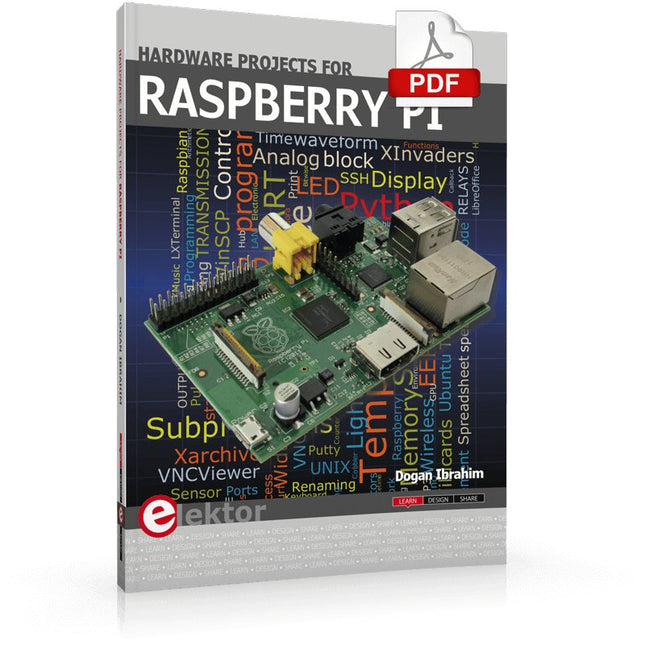
Elektor Digital Hardware Projects for Raspberry Pi (E-book)
The Raspberry Pi is a $35 credit-card sized computer with many applications, such as in desktop computing, audio and video playback, and as a controller in many industrial, commercial and domestic applications. This book is about the Raspberry Pi computer and its use in control applications. The book explains in simple terms, with examples, how to configure the RPi, how to install and use the Linux operating system, how to write programs using the Python programming language and how to develop hardware based projects. The book starts with an introduction to the Raspberry Pi computer and covers the topics of purchasing all the necessary equipment and installing/using the Linux operating system in command mode. Use of the user-friendly graphical desktop operating environment is explained using example applications. The RPi network interface is explained in simple steps and demonstrates how the computer can be accessed remotely from a desktop or a laptop computer. The remaining parts of the book cover the Python programming language, hardware development tools, hardware interface details, and RPi based hardware projects. All the 23 projects given in the book have been tested and are working. The following headings are given for each project: Project title Project description Project block diagram Project circuit diagram Project program description using the Program Description Language (PDL) Complete program listing Description of the program The book is ideal for self-study, and is intended for electronic/electrical engineering students, practising engineers, research students, and hobbyists.
€ 34,95
Mitglieder € 27,96
-
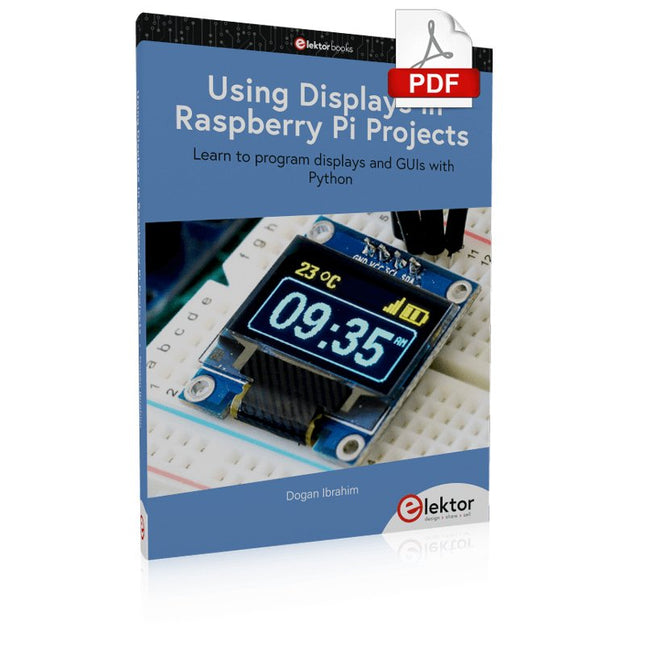
Elektor Digital Using Displays in Raspberry Pi Projects (E-book)
Learn to program displays and GUIs with Python This book is about Raspberry Pi 4 display projects. The book starts by explaining how to install the latest Raspbian operating system on an SD card, and how to configure and use the GPIO ports. The core of the book explains the following topics in simple terms with fully tested and working example projects: Simple LED projects Bar graph LED projects Matrix LED projects Bitmap LED projects LED strips LCDs OLED displays E-paper displays TFT displays 7-inch touch screen GUI Programming with Tkinder One unique feature of this book is that it covers almost all types of display that readers will need to use in their Raspberry Pi based projects. The operation of each project is fully given, including block diagrams, circuit diagrams, and commented full program listings. It is therefore an easy task to convert the given projects to run on other popular platforms, such as Arduino or PIC microcontrollers. Python program listings of all Raspberry Pi projects developed in this book are available for download at Elektor.com. Readers can use these programs in their projects. Alternatively, they can modify the programs to suit their applications.
€ 32,95
Mitglieder € 26,36
-

JOY-iT JOY-iT Motorino - Motorsteuerung für Arduino
Die Motorino-Platine ist eine Erweiterungsplatine zur Ansteuerung und Verwendung von bis zu 16 PWM-gesteuerten 5-V-Servomotoren. Der eigene Taktgeber auf dem Motorino sorgt für ein sehr genaues PWM-Signal und somit eine genaue Positionierung. Die Platine verfügt über 2 Eingänge für Spannung von 4,8-6 V, über die zusammen bis zu 11 A eingespeist werden können, sodass eine optimale Versorgung der Motoren stets gewährleistet ist und somit auch größere Projekte mit ausreichend Strom beliefert werden können. Die Versorgung läuft zentral über den Motorino, der für jeden Motor separat einen Anschluss für Spannung, Masse und die Steuerleitung zur Verfügung stellt. Durch den eingebauten Kondensator wird der Strom zusätzlich gepuffert, hierdurch wird das Einbrechen der Spannung bei kurzzeitiger Mehrbelastung reduziert, die sonst zum Ruckeln führen könnte. Zusätzlich hat man noch die Möglichkeit, einen weiteren Kondensator anzuschließen. Die Ansteuerung und Programmierung der Motoren kann (wie gewohnt) weiterhin bequem über den Arduino bedient werden. Anleitung und Codebeispiele erlauben auch Einsteigern, schnell Ergebnisse zu erzielen. Besonderheiten 16 Kanäle, eigener Taktgeber für Servomotoren (PWM) Eingang 1 Hohlstecker 5,5 / 2,1 mm , 4,8-6 V / 5 A max Eingang 2 Schraubklemme, 4,8-6 V / 6 A max Kommunikation 16 x PWM Kompatibel mit Arduino Uno, Mega und viele weitere Mikrovontroller mit Arduino-kompatiblem Pinout Maß (BxHxT) 69 x 24 x 56 mm Lieferumfang Platine, Bedienungsanleitung, Retail-Verpackung
€ 26,95€ 13,50
Mitglieder identisch
-
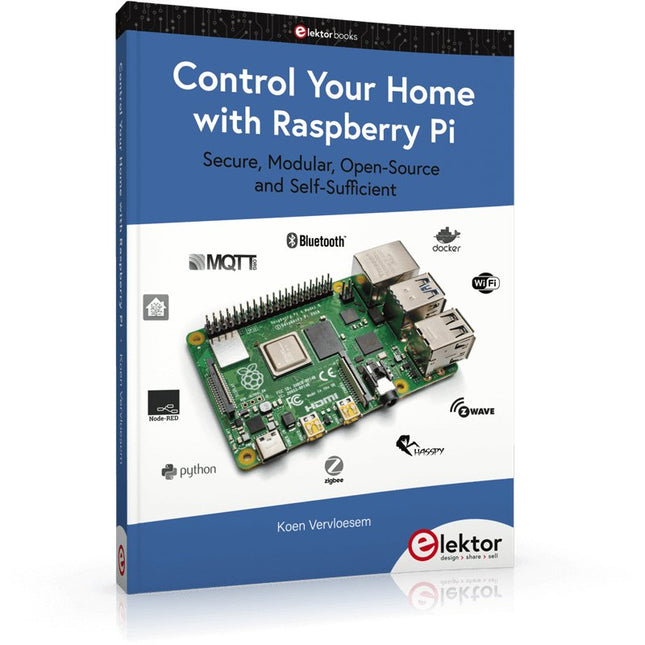
Elektor Publishing Control Your Home with Raspberry Pi
Secure, Modular, Open-Source and Self-Sufficient Ever since the Raspberry Pi was introduced, it has been used by enthusiasts to automate their homes. The Raspberry Pi is a powerful computer in a small package, with lots of interfacing options to control various devices. This book shows you how you can automate your home with a Raspberry Pi. You’ll learn how to use various wireless protocols for home automation, such as Bluetooth, 433.92 MHz radio waves, Z-Wave, and Zigbee. Soon you’ll automate your home with Python, Node-RED, and Home Assistant, and you’ll even be able to speak to your home automation system. All this is done securely, with a modular system, completely open-source, without relying on third-party services. You’re in control of your home, and no one else. At the end of this book, you can install and configure your Raspberry Pi as a highly flexible home automation gateway for protocols of your choice, and link various services with MQTT to make it your own system. This DIY (do it yourself) approach is a bit more laborious than just installing an off-the-shelf home automation system, but in the process, you can learn a lot, and in the end, you know exactly what’s running your house and how to tweak it. This is why you were interested in the Raspberry Pi in the first place, right? Turn your Raspberry Pi into a reliable gateway for various home automation protocols. Make your home automation setup reproducible with Docker Compose. Secure all your network communication with TLS. Create a video surveillance system for your home. Automate your home with Python, Node-RED, Home Assistant and AppDaemon. Securely access your home automation dashboard from remote locations. Use fully offline voice commands in your own language. Downloads Errata on GitHub
€ 44,95
Mitglieder € 40,46
-

Raspberry Pi Foundation Raspberry Pi Build HAT
Bauen Sie robuste, intelligente Maschinen, die die Rechenleistung des Raspberry Pi mit LEGO-Komponenten kombinieren. Der Raspberry Pi Build HAT bietet vier Anschlüsse für LEGO Technic Motoren und Sensoren aus dem SPIKE Portfolio. Zu den verfügbaren Sensoren gehören ein Abstandssensor, ein Farbsensor und ein vielseitiger Kraftsensor. Die Winkelmotoren sind in verschiedenen Größen erhältlich und verfügen über integrierte Encoder, die ihre Position abfragen können. Der Build HAT passt auf alle Raspberry Pi-Computer mit einem 40-Pin-GPIO-Header, einschließlich – mit der Hinzufügung eines Flachbandkabels oder eines anderen Erweiterungsgeräts – Raspberry Pi 400. Angeschlossene LEGO Technic-Geräte können neben Standard-Raspberry-Pi-Zubehör problemlos in Python gesteuert werden wie zum Beispiel ein Kameramodul. Merkmale Steuert bis zu 4 Motoren und Sensoren Versorgt den Raspberry Pi mit Strom (bei Verwendung mit einem geeigneten externen Netzteil) Einfache Verwendung von Python auf dem Raspberry Pi
€ 29,95€ 14,95
Mitglieder identisch
-
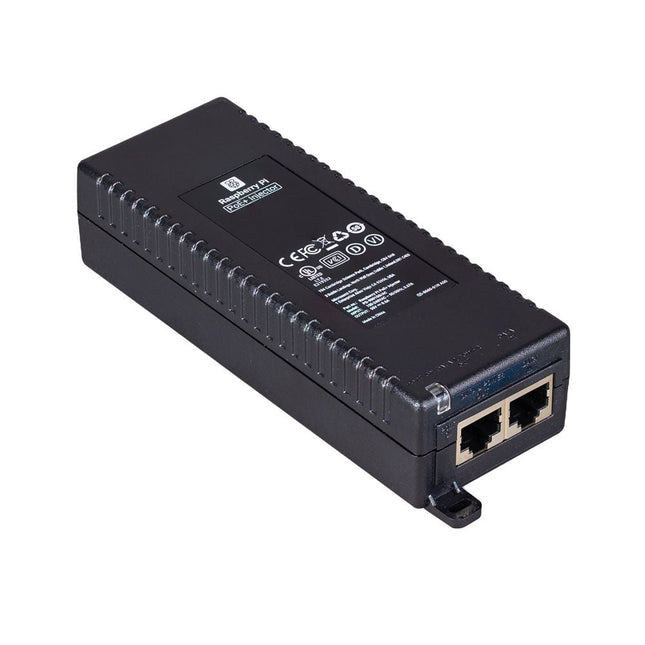
Raspberry Pi Foundation Raspberry Pi PoE+ Injector
Der Raspberry Pi PoE+ Injektor erweitert einen einzelnen Port eines Nicht-PoE-Ethernet-Switches um Power-over-Ethernet (PoE)-Funktionalität und überträgt Strom und Daten über ein einziges Ethernet-Kabel. Er bietet eine kostengünstige Plug-and-Play-Lösung für die schrittweise Einführung von PoE in bestehende Ethernet-Netzwerke. Der PoE+ Injektor ist ein 30-W-Gerät mit einem Port und eignet sich zur Stromversorgung von Geräten gemäß den Standards IEEE 802.3af und 802.3at, einschließlich aller Generationen von Raspberry Pi PoE HATs. Er unterstützt Netzwerk-Passthrough-Geschwindigkeiten von 10/100/1000 Mbit/s. Hinweis: Für den Betrieb ist ein separates IEC-Netzkabel erforderlich (nicht im Lieferumfang enthalten). Technische Daten Datenrate 10/100/1000 Mbit/s Eingangsspannung 100 bis 240 V AC Ausgangsleistung 30 W Leistungsabgabe an den Pins 4/5 (+), 7/8 (–) Nennausgangsspannung 55 V DC Datenanschlüsse Geschirmte RJ-45-, EIA 568A- und 568B Stromanschluss IEC C13-Netzeingang (nicht im Lieferumfang enthalten) Luftfeuchtigkeit bei Lagerung Maximal 95%, nicht kondensierend Betriebshöhe –300 m bis 3000 m Betriebsumgebungstemperatur 10°C bis +50°C Abmessungen 159 x 51,8 x 33,5 mm Downloads Datasheet
€ 29,95€ 14,95
Mitglieder identisch
-

Elektor Publishing PID-basierte digitale Regelungstechnik mit Raspberry Pi und Arduino Uno
Der Arduino Uno ist ein Open-Source-Mikrocontroller-Entwicklungssystem, das Hardware, eine integrierte Entwicklungsumgebung (IDE) und eine Vielzahl von Bibliotheken umfasst. Es wird von einer riesigen Gemeinschaft von Programmierern, Elektronikern, Enthusiasten und Akademikern unterstützt. Insbesondere die Bibliotheken erleichtern die Programmierarbeit und reduzieren die Entwicklungszeiten, da sie das Erstellen von Programmen erheblich erleichtern. Der Raspberry Pi 4 kann in vielen Projekten wie Audio- und Videoanwendungen, aber auch in Industriesteuerungen, Robotik, Spielen usw. eingesetzt werden. Dazu bietet er auch WiFi- und Bluetooth-Fähigkeiten, wodurch er sich zudem hervorragend für internetbasierte Steuerungs- und Überwachungsanwendungen eignet. In diesem Buch werden sowohl der Raspberry Pi 4 als auch der Arduino Uno in PID-basierten automatischen Steuerungsanwendungen eingesetzt. Nach einer grundlegenden Theorie der Regelsysteme werden funktionierende und getestete Projekte zur Steuerung realer Systeme mit PID-Reglern vorgestellt. Die Open-Loop-Eigenschaften, die Abstimmung der PID-Parameter und das Closed-Loop-Zeitverhalten der Systeme werden zusammen mit Blockdiagrammen, Schaltplänen und PID-Regelalgorithmen ausführlich diskutiert. Vollständige Programme für den Raspberry Pi und den Arduino Uno runden die im Buch vorgestellten Projekte ab. Die Regelsysteme können problemlos auch auf andere Projekte angewendet werden und die für den Raspberry Pi 4 angegebenen Programme sollten auch mit anderen Modellen der Raspberry Pi-Familie reibungslos funktionieren. Das Buch behandelt folgende Themen: Steuer- und Regelsysteme Analoge und digitale Sensoren Übertragungsfunktionen und zeitkontinuierliche Systeme Systemantwortfunktionen erster und zweiter Ordnung Zeitdiskrete digitale Systeme Zeitkontinuierliche PID-Regler Zeitdiskrete PID-Regler Zweipunkt-Temperaturregelung mit Raspberry Pi und Arduino Uno PID-basierte Temperaturregelung mit Raspberry Pi und Arduino Uno Motorsteuerung mit Raspberry Pi und Arduino Uno Wasserstandsregelung mit Raspberry Pi und Arduino Uno PID-basierte LED-Helligkeitsregelung mit Raspberry Pi und Arduino Uno
€ 39,80
Mitglieder identisch
-

Elektor Digital Raspberry Pi 3 – Basic to Advanced Projects (E-book)
This book is about the Raspberry Pi 3 computer and its use in various control and monitoring applications. The book explains in simple terms and with tested and working example projects, how to configure the Raspberry Pi 3 computer, how to install and use the Linux operating system, and how to write hardware based applications programs using the Python programming language. The nice feature of this book is that it covers many Raspberry Pi 3 based hardware projects using the latest hardware modules such as the Sense HAT, Swiss Pi, MotoPi, Camera module, and many other state of the art analog and digital sensors. An important feature of the Raspberry Pi 3 is that it contains on-board Bluetooth and Wi-Fi modules. Example projects are given in the book on using the Wi-Fi and the Bluetooth modules to show how real-data can be sent to the Cloud using the Wi-Fi module, and also how to communicate with an Android based mobile phone using the Bluetooth module. The book is ideal for self-study, and is intended for electronic/electrical engineering students, practising engineers, research students, and for hobbyists. It is recommended that the book should be followed in the given Chapter order. Over 30 projects are given in the book. All the projects in the book are based on the Python programming language and they have been fully tested. Full program listings of every project are given in the book with comments and full descriptions. Experienced programmers should find it easy to modify and update the programs to suit their needs. The following sub-headings are given for each project to make it as easy as possible for the readers to follow the projects: Project title Description Aim of the project Raspberry Pi type Block diagram Circuit diagram Program listing
€ 29,95
Mitglieder € 23,96
-
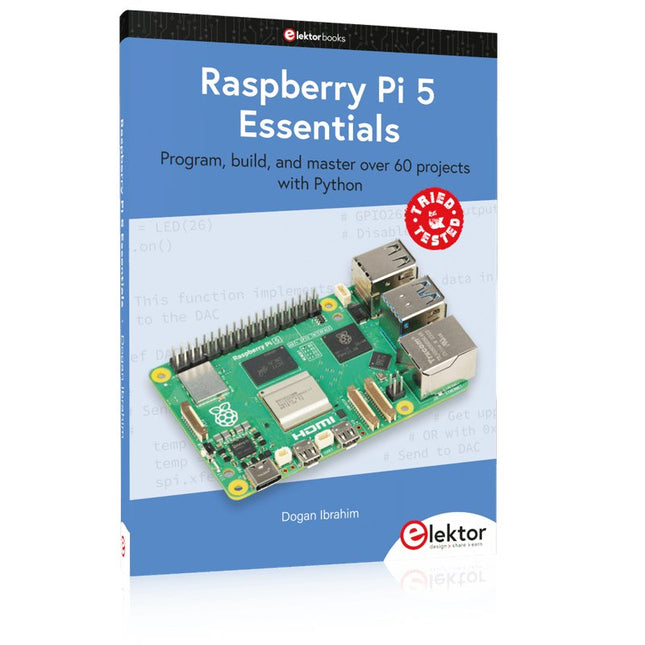
Elektor Publishing Raspberry Pi 5 Essentials
Program, build, and master over 60 projects with Python The Raspberry Pi 5 is the latest single-board computer from the Raspberry Pi Foundation. It can be used in many applications, such as in audio and video media centers, as a desktop computer, in industrial controllers, robotics, and in many domestic and commercial applications. In addition to the well-established features found in other Raspberry Pi computers, the Raspberry Pi 5 offers Wi-Fi and Bluetooth (classic and BLE), which makes it a perfect match for IoT as well as in remote and Internet-based control and monitoring applications. It is now possible to develop many real-time projects such as audio digital signal processing, real-time digital filtering, real-time digital control and monitoring, and many other real-time operations using this tiny powerhouse. The book starts with an introduction to the Raspberry Pi 5 computer and covers the important topics of accessing the computer locally and remotely. Use of the console language commands as well as accessing and using the desktop GUI are described with working examples. The remaining parts of the book cover many Raspberry Pi 5-based hardware projects using components and devices such as LEDs and buzzers LCDs Ultrasonic sensors Temperature and atmospheric pressure sensors The Sense HAT Camera modules Example projects are given using Wi-Fi and Bluetooth modules to send and receive data from smartphones and PCs, and sending real-time temperature and atmospheric pressure data to the cloud. All projects given in the book have been fully tested for correct operation. Only basic programming and electronics experience are required to follow the projects. Brief descriptions, block diagrams, detailed circuit diagrams, and full Python program listings are given for all projects described.
€ 39,95
Mitglieder € 35,96











